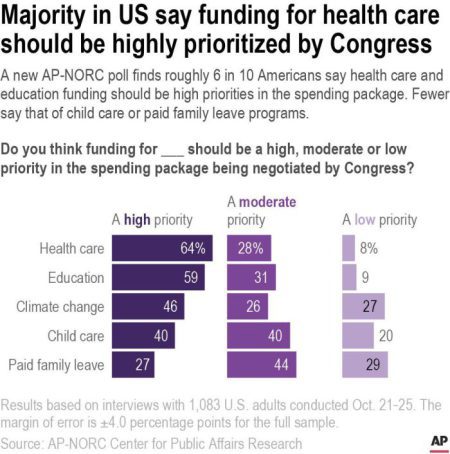The Associated Press
October 15, 2021
Americans have watched a public reckoning unfold since 2017 as the #MeToo movement exposed the enduring prevalence of sexual assault and harassment in people’s lives. A string of powerful men were taken down in its wake.
But has the movement changed their own lives in meaningful, measurable ways?
A new poll suggests that it has. Roughly half of Americans — 54% — say the recent attention to the issue has made them more likely to speak out if they were a victim of sexual misconduct, according to a poll from The Associated Press-NORC Center for Public Affairs Research.
And 58% say they are more willing to speak out if they were to witness it happening.
Among other findings in the survey of American adults, conducted Sept 23-27:
— About 6 in 10 women and roughly 4 in 10 men say the attention to sexual misconduct has made them more likely to speak out if they are victimized. Women also are especially likely to they feel more willing to report sexual misconduct they witness, though many men say they say they would, too (63% of women and 53% of men).
— The majority of Americans, 61%, say the recent attention to sexual misconduct in the U.S. has been good for women in general, up from 45% in January 2020. Now, just 19% say it has been negative; another 19% say there has not been much impact.
— Nearly half — 45% — say it’s been good for the country, while 24% say it’s had a detrimental effect. That’s also a significant change since January 2020, when Americans were more closely divided over the impact: 33% said positive, while 38% said negative.
— Somewhat more people now feel the movement has been good for men as well: 25% say so, compared with 19% in 2020.
— Overall, respondents see fewer signs of positive change for women of color compared with women in general. Forty-one percent say the movement has had a good impact, though just 18% say it has been negative. However, women of color are more positive about the effect the movement has had on them personally. Four in 10 say the movement has been good for them. That’s more than the 25% of white women who feel that way.
— Black Americans are especially likely to say the impact on men of color has been negative. Nearly half — 45% — feel that’s the case, compared with 28% of Americans overall.
— More Americans under 30 say they have talked with others about sexual misconduct (45% vs. 31%) and changed how they interact with others (34% vs. 24%) in the past year.
— More Democrats than Republicans say they have discussed the issue in the past year, 41% vs. 27%.
— Just 35% of Americans now say sexual misconduct is an “extremely” or “very” serious problem in the workplace, down from 56% in 2017. Still, another 47% say it’s a “somewhat” serious problem in workplaces today.
— About 6 in 10 call sexual misconduct on social media an “extremely” or “very” serious problem.
___
The AP-NORC poll of 1,099 adults was conducted Sept. 23-27 using a sample drawn from NORC’s probability-based AmeriSpeak Panel, which is designed to be representative of the U.S. population. The margin of sampling error for all respondents is plus or minus 4.2 percentage points.


